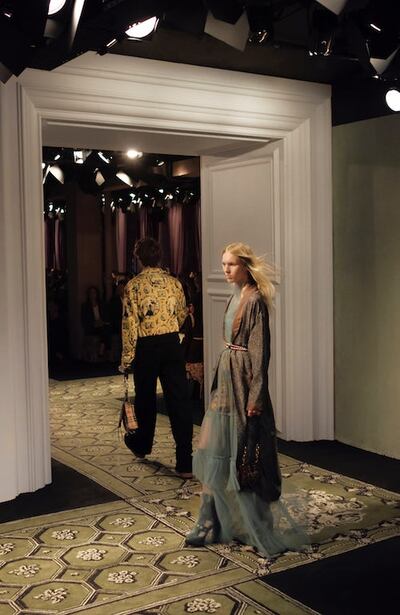
The Business of Fashion
Agenda-setting intelligence, analysis and advice for the global fashion community.

Agenda-setting intelligence, analysis and advice for the global fashion community.

LONDON, United Kingdom — Following months of industry speculation on the subject, on February 5th 2016, Burberry became the first major fashion house to announce a realignment of its show calendar by combining men's and women's collections into twice-annual seasonless shows. That very same day, Tom Ford announced a plan to postpone his fashion show for six months to show in September and make the collection immediately available to consumers.
Within a week, they were joined by Tommy Hilfiger, Paul Smith and a number of smaller designer brands — all publicly announcing a shift to some form of fashion immediacy strategy, seeking to better rationalise the fashion show calendar for consumers and capitalise on immediate demand for runway products.
However, the global fashion industry has been neither united nor unanimous in its view on this break from tradition. In fact, some of its most influential figures went on record against the shifts in strategy, including senior representatives of the two biggest luxury fashion conglomerates LVMH and Kering, as well as the leaders of national fashion associations such as the Fédération Française de la Couture du Prêt-à-Porter des Couturiers et des Créateurs de Mode and the Camera Nazionale della Moda Italiana.
Kering's chairman and chief executive François-Henri Pinault said in a statement that fashion immediacy "negated the dream of luxury," and that delayed gratification (rather than instant gratification) is what "creates desire." The task force put together by Ralph Toledano, president of the Fédération Française de la Couture, which comprised of Sidney Toledano, chief executive of Christian Dior, and Bruno Pavlovsky, Chanel's president of fashion, amongst others, took the position that, "the present system was valid."
ADVERTISEMENT
While some industry leaders — based mostly in New York and London — advocated for rapid change, the French and Italian designer establishment seemed to prefer the status quo. And given the latter’s collective weight in the global fashion industry, the move toward fashion immediacy became a matter for companies to tackle individually.
Despite the industry’s internal divisions, a variety of fashion immediacy strategies have emerged throughout 2016. Some of these reflect a longer-term evolution that has been sweeping the industry in recent years. As high-street players increasingly adopted the fast-fashion business model, more high-end designers introduced pre-fall, cruise, resort and holiday collections. This effectively increased the pace and number of deliveries from the traditional Spring/Summer and Autumn/Winter seasons.
It's always felt a little alien, inviting people from around the world to watch, to Instagram, share and like, but then not be able to buy it, until four to six months later.
Consequently, today, many luxury brands present six shows for the three different ready-to-wear collections: two each for womenswear mainline, womenswear pre-collections and menswear. But although they had increased the number of product drops throughout the year, brands found themselves creating publicity around these collections months before consumers were able to buy them at retail.

Burberry September 2016 show | Source: Courtesy
"It's always felt a little alien, inviting people from around the world to tune in and to watch, to Instagram, share and like and all of those things, but then not be able to buy it, or look at it, until four to six months [later]. I found [the shift to fashion immediacy] great — a natural thing," says Christopher Bailey, chief creative officer and chief executive of Burberry.
Looking ahead, several contemporaneous factors will continue to drive the industry’s adoption of fashion immediacy strategies in 2017. The first is the need for organic growth in a challenging global economic climate. Ninety-five percent of the business executives polled in the BoF-McKinsey Global Fashion Survey believe that driving sales growth, rather than cutting costs, will be the key focus to increase profits in 2017. Brands can view fashion immediacy as an attractive potential growth lever, to address the traditional fashion system’s inability to concurrently serve the needs of a global consumer base and to better capitalise on the media and consumer interest in fashion shows.
Another factor is the belief that some consumers demand fashion immediacy and view it as a natural progression for fashion brands. “We listened to the consumer and understood that [what] they are demanding is instant gratification and experiences,” says Tommy Hilfiger, founder and designer of his eponymous brand.
Arguably, the rise of B2C fashion shows, photo-sharing social media apps and e-commerce have already shifted consumer preferences toward immediate gratification and heightened expectations for newness. Some believe that changing the fashion cycle is simply a sign that brands are catching up. “The traditional ‘attraction of anticipation’ will still exist, but there has to be some change. We are living in a radically different world,” says Bailey.
ADVERTISEMENT
But what does it take for fashion brands to operationalise fashion immediacy to their consumers — and is it worth it?
Aligning Everyone to a New Internal Calendar
To disrupt the established fashion calendar, which fails to take into account seasonal differences in southern and northern hemisphere markets, Burberry and Tommy Hilfiger completely shifted execution deadlines and decision-making processes. “It took a lot of work to recreate our calendar. We had to have intense synchronisation across every different aspect of our business,” explains Avery Baker, chief brand officer at Tommy Hilfiger and the chief-architect of its move to fashion immediacy.
Previously, samples would have been debuted at the runway show, but the new schedules mean they are made around three months before the show.
“You normally design the full show, then you show the show and then your supply chain starts to kick in,” Bailey told BoF when he announced the change. But for the latest Burberry show, Bailey had to develop production techniques, deadlines and budgets as a part of the design process. “Now, as we are designing the show we will be passing things over immediately to our supply chain partners to say, ‘Let’s look at the lead times on this; how can we work with this factory to get this on the date that we need it?” he continues.
There are also implications for wholesale partners and press, who must see the collection before the show and place their orders in advance. Restricted showrooms were set up for key international wholesale buyers and press to view the collection in the strictest of confidence, at times secured through non-disclosure agreements. In Burberry's showroom, accessories were also displayed, as well as inspiration boards with images, photographs and swatches of fabric to give the clearest possible sense of the collection's themes.
A Positive or Negative Impact on Creativity?
More pessimistic observers have questioned the impact of fashion immediacy on the creative process, predicting that collections would inevitably become watered-down, overtly commercial or lack the dream and anticipation that have sustained fashion marketing for decades. But according to both Bailey and Hilfiger, rather than a creative constraint as detractors claim, the earlier deadlines brought on by fashion immediacy strategies offer time for reflection and can therefore award creative advantages.
ADVERTISEMENT

Burberry Makers House | Source: Courtesy
“It gave us time to unpack the inspiration, the stories, the artisans that went behind it, the craft that went behind it [and] the music that was the spirit of the collection,” says Bailey, who created an art and craft infused collection and exhibition for the Burberry collection presented in September 2016 at Makers House, where artisan weavers, bookbinders, calligraphers and saddlers — all linked to London concept store The New Craftsmen — were on hand.
The move to fashion immediacy has been very important to help Burberry “join all of the dots,” he explains, so that audiences around the world avoid a transactional relationship whether they be in store, on social platforms, or elsewhere.
Baker says that Tommy Hilfiger’s pivot toward fashion immediacy was also a boost for creativity: “It was an extremely dynamic process, having that adaptability and agility to find interesting and fresh ways to tell the story, we actually found [it] to be super creative. I think our own team was even inspired and surprised at how the final show came together because it felt really fresh,” she says.
Bailey goes so far as to call claims of fashion immediacy’s negative impact on creativity “an incredibly patronising” argument. “We designers are not stupid; we do have brain cells and we’re not constrained by timings. We will find solutions to these problems,” he asserts.
There are, however, some creative aspects where the shift in timing is absolute. Communications assets for the new season must now be immediately available following the show, impacting the highly pressured work schedules of the creative teams who craft communications strategies, from photographers to art-directors, make-up artists to hair stylists. In September 2016, when Mario Testino took his place front row at the Burberry show, he had shot the accompanying ad campaign, which was already in the hands of Anna Wintour, American Vogue's editor-in-chief, to run in the magazine.
In practice, it seems likely that maintaining “the dream” aspect of luxury will be sustained through key runway pieces. For example, Burberry’s military band jackets featured heavily in the show as well as the advertising imagery and editorials that came afterwards. The ability to presage what runway looks to manufacture in significant numbers and balance them with commercial pieces will define early success with the strategy.
A More Flexible Collection for Wholesalers
One notable commercial consequence of earlier deadlines and extended manufacturing time frames is the opportunity for brands to sell a complete package to wholesale partners. “In our previous model, a collection was developed, shown and campaigns would follow six months later. This new model enabled us to go to market and to our key wholesale partners with a really cohesive story from product through to marketing — the entire consumer journey,” says Baker.
In one sense, she suggests, fashion immediacy actually offers brands more flexibility. Designers can adapt a collection right up to the point of delivery, thus integrating of-the-moment trends, says Baker, revealing that “30 to 40 percent of products that [Tommy Hilfiger] had in the show were pieces that, after the close of the traditional season, we were able to go back and design and produce and even sell on a fast-track model.”
“We could really see what we were missing, and what consumers were really looking for and interested in. It allowed us to have a more dynamic approach to what would traditionally be pretty locked into that collection otherwise from day one,” she adds.
While critics have suggested that this more responsive design approach leads to increased levels of plagiarism in the industry, it does offer appreciable commercial advantage. "Accounts who wouldn't normally buy on a
shorter lead-time wanted the pieces that we injected later. They were more interested in the things that felt a little closer to market, a little quicker in terms of the trend," Baker says.
Coordinating Retail Refreshment for Global Distribution
However, the advantages of being able to tailor collections to more current trends and sell fully realised concepts to wholesalers must be weighed against the operational complexity of consecutively unveiling so-called “See Now, Buy Now” collections across global distribution chains. A business on the scale of Tommy Hilfiger, for example, sells through 20,000 points of sale, in more than 1,500 stores in over 115 countries. Burberry’s collection was available for purchase immediately after the show from the company’s flagship stores, on its website and at selected wholesale partners including Barneys New York, Colette in Paris and Hong Kong-based travel retailer DFS Group. The show sparked “an instant uplift in sales,” according to Michael Kliger, president of MyTheresa.com.
Though difficult to coordinate across global markets, immediately available product drops can capitalise on buzz in the same manner that cult streetwear brands create when releasing runs of product following their own schedule. “I really believe that the new way to do it is as instantaneously as possible and also packed full of surprises. There has to be excitement, experience and an element of surprise and disruption around it. You can call it fast fashion but [this] is what’s keeping customers excited and engaged,” says Hilfiger.
However maintaining consumer interest in the collection throughout the season requires more forward planning. “One of the things that we did around the last show was to really tackle how can we take this opportunity to create fantastic content that we can then use later in the season, weeks or even a month or two after the show, creating another spike of engagement and interest with our followers,” explains Baker.
To sustain interest in its collection, Hilfiger entered into partnerships with Facebook and Vogue, among others. “[The partnerships] create fresh interest around the show. I think that definitely can and should evolve significantly in the future, to be able to showcase new content linked simultaneously with new product drops,” she continues.
Whether it is possible to maintain margins while keeping fashion’s fussiest consumers excited and engaged by investing heavily in the manipulation of an increasingly complex fashion cycle remains to be seen. But ignoring the tectonic shifts being felt in a marketplace led by ever demanding consumers — always switched on and expecting brands to constantly stimulate them — carries a significant risk too.
As Bailey says, “Everyone is changing the way they live, work, shop, eat — our industry is not immune to that change, and our customers are not immune to those changes [either].”

The State of Fashion 2017 is The Business of Fashion and McKinsey & Company's in-depth report on the global fashion industry in 2017, focusing on the themes, issues and opportunities impacting the sector and its performance.
From analysis of the global fashion and beauty industries to career and personal advice, BoF’s founder and CEO, Imran Amed, will be answering your questions on Sunday, February 18, 2024 during London Fashion Week.
The State of Fashion 2024 breaks down the 10 themes that will define the industry in the year ahead.
Imran Amed reviews the most important fashion stories of the year and shares his predictions on what this means for the industry in 2024.
After three days of inspiring talks, guests closed out BoF’s gathering for big thinkers with a black tie gala followed by an intimate performance from Rita Ora — guest starring Billy Porter.